Multi-Target Localization and Tracking Using TDOA and AOA Measurements Based on Gibbs-GLMB Filtering †
Abstract
1. Introduction
2. Background
2.1. NOTATION
- Single-target state is expressed by a small letter, (e.g., x).
- Multi-target states are represented by an italic capital letter, (e.g., X).
- The labeled states and distribution are bolded, (e.g., ).
- The spaces are represented by blackboard bold (e.g., the state space and measurement space ).
- is the all finite subsets of .
- The inner product symbol is abbreviated as:.
- The following multi-target exponential notation , where h is a real-valued function, with .
- The generalization of the Kronecker delta for sets, vectors and integers:where inclusion function is denoted as:
- is shorthand for the list of variables .
2.2. Random Finite Set
2.3. Multi-Bernoulli RFS
2.4. Labeled Multi-Bernoulli RFS
2.5. GLMB RFS
3. Problem Formulation
3.1. Model Environment
3.1.1. Time Difference of Arrival
3.1.2. Angle of Arrival
3.2. Measurement
3.2.1. TDOA Measurement
3.2.2. AOA Measurement
3.3. Motion Model
4. TDOA Localization Algorithm Based on SMC-GLMB Filtering
4.1. Target State Estimation
4.2. Particle Filter Implementation
| Algorithm 1 Particle Filter |
|
4.3. The Multi-Sensor Likelihood
4.4. GLMB Filter
4.5. Gibbs-GLMB Filter
| Algorithm 2 Gibbs sampling |
|
5. Experiment
5.1. Simulation Environment Settings
5.2. Algorithm Estimation Analysis
5.2.1. Scenario 1
5.2.2. Scenario 2
5.3. Performance
6. Conclusions
Author Contributions
Funding
Conflicts of Interest
References
- Wang, X.; Liu, W.; Chen, Y. Passive localization based on multi-sensor GLMB filter Using a TDOA Approach. In Proceedings of the 2017 36th Chinese Control Conference (CCC), Dalian, China, 26–28 July 2017; pp. 5230–5235. [Google Scholar]
- Brandstein, M.S.; Silverman, H.F. A practical methodology for speech source localization with microphone arrays. Comput. Speech Lang. 1997, 11, 91–126. [Google Scholar] [CrossRef]
- Schmidt, R. Multiple emitter location and signal parameter estimation. IEEE Trans. Antennas Propag. 1986, 34, 276–280. [Google Scholar] [CrossRef]
- Knapp, C.; Carter, G. The generalized correlation method for estimation of time delay. Signal Process. 1976, 24, 320–327. [Google Scholar] [CrossRef]
- Xu, L.; Liang, Y.; Duan, Z.; Zhou, G. Route-based dynamics modeling and tracking with application to air traffic surveillance. IEEE Trans. Intell. Transp. Syst. 2019. [Google Scholar] [CrossRef]
- Yang, J.; Zhang, M. Research on Multi Source Heterogeneous Data Fusion Location Algorithm Based on Active Detection and Passive Acquisition. Acta Electron. Sin. 2018, 46, 165–169. [Google Scholar] [CrossRef]
- Cao, H.; Chan, Y.T.; So, H.C. Maximum Likelihood TDOA Estimation from Compressed Sensing Samples without Reconstruction. IEEE Signal Process. Lett. 2017, 24, 564–568. [Google Scholar] [CrossRef]
- Wang, Y.; Ho, K.C. TDOA Positioning Irrespective of Source Range. IEEE Trans. Signal Process. 2017, 65, 1447–1460. [Google Scholar] [CrossRef]
- Zhong, X.; Hopgood, J.R. Particle filtering for TDOA based acoustic source tracking: Nonconcurrent Multiple Talkers. Signal Process. 2014, 96, 382–394. [Google Scholar] [CrossRef]
- Vo, B.-N.; Mallick, M.; Bar-Shalom, Y.; Coraluppi, S.; Osborne, R., III; Mahler, R.; Vo, B.-T. Multitarget Tracking; Wiley Encyclopedia of Electrical and Electronics Engineering: New York, NY, USA, September 2015. [Google Scholar]
- Mahler, R. Multitarget Bayes filtering via first-order multitarget moments. IEEE Trans. Aerosp. Electron. Syst. 2003, 39, 1152–1178. [Google Scholar] [CrossRef]
- Mahler, R. PHD filters of higher order in target number. IEEE Trans. Aerosp. Electron. Syst. 2007, 43, 1523–1543. [Google Scholar] [CrossRef]
- Mahler, R. Statistical Multisource-Multitarget Information Fusion; Artech House: Norwood, MA, USA, 2007. [Google Scholar]
- Mahler, R. Advances in Statistical Multisource-Multitarget Information Fusion; Artech House: Norwood, MA, USA, 2014. [Google Scholar]
- Vo, B.-N.; Vo, B.-T.; Pham, N.-T.; Suter, D. Joint Detection and Estimation of Multiple Objects from Image Observations. IEEE Trans. Signal Process. 2010, 58, 5129–5241. [Google Scholar] [CrossRef]
- Vo, B.-N.; Singh, S.; Doucet, A. Sequential Monte Carlo methods for multi-target filtering with random finite sets. IEEE Trans. Aerosp. Electron. Syst. 2005, 41, 1224–1245. [Google Scholar]
- Vo, B.-N.; Ma, W.K. The Gaussian mixture Probability Hypothesis Density Filter. IEEE Trans. Signal Process. 2006, 54, 4091–4104. [Google Scholar] [CrossRef]
- Vo, B.-T.; Vo, B.-N.; Cantoni, A. The Cardinality Balanced Multi-target Multi-Bernoulli filter and its implementations. IEEE Trans. Signal Process. 2009, 57, 409–423. [Google Scholar]
- Vo, B.-T.; Vo, B.-N.; Cantoni, A. Analytic implementations of the Cardinalized Probability Hypothesis Density Filter. IEEE Trans. Sig. Proc. 2007, 55 Pt 2, 3553–3567. [Google Scholar] [CrossRef]
- Maggio, E.; Taj, M.; Cavallaro, A. Efficient multitarget visual tracking using random finite sets. IEEE Trans. Circuits Syst. Video Technol. 2008, 18, 1016–1027. [Google Scholar] [CrossRef]
- Hoseinnezhad, R.; Vo, B.-N.; Vo, B.T.; Suter, D. Visual tracking of numerous targets via multi-bernoulli filtering of image data. Pattern Recognit. 2012, 45, 3625–3635. [Google Scholar] [CrossRef]
- Hoseinnezhad, R.; Vo, B.-N.; Vo, B.-T. Visual tracking in background subtracted image sequences via multi-bernoulli filtering. IEEE Trans. Signal Process. 2013, 61, 392–397. [Google Scholar] [CrossRef]
- Ristic, B.; Vo, B.-N. Sensor Control for Multi-Object State-Space Estimation Using Random Finite Sets. Automatica 2010, 46, 1812–1818. [Google Scholar] [CrossRef]
- Ristic, B.; Vo, B.-N.; Clark, D. A note on the reward function for PHD filters with sensor control. IEEE Trans. Aerosp. Electron. Syst. 2011, 47, 1521–1529. [Google Scholar] [CrossRef]
- Yi, W.; Li, S.; Wang, B.; Hoseinnezhad, R.; Kong, L. Computationally Efficient Distributed Multi-sensor Fusion with Multi-Bernoulli Filter. IEEE Trans. Signal Process. 2020. [Google Scholar] [CrossRef]
- Hoang, H.G.; Vo, B.T. Sensor management for multi-target tracking via multi-Bernoulli filtering. Automatica 2014, 50, 1135–1142. [Google Scholar] [CrossRef]
- Hoang, H.; Vo, B.-N.; Vo, B.-T.; Mahler, R. The Cauchy-Schwarz divergence for Poisson point processes. IEEE Trans. Inf. Theory 2015, 61, 4475–4485. [Google Scholar] [CrossRef]
- Gostar, A.K.; Hoseinnezhad, R.; Bab-Hadiashar, A. Multi-Bernoulli sensor control using Cauchy-Schwarz divergence. In Proceedings of the 2016 19th International Conference on Information Fusion (FUSION), Heidelberg, Germany, 5–8 July 2016; pp. 651–657. [Google Scholar]
- Gostar, A.K.; Hoseinnezhad, R.; Bab-Hadiashar, A. Multi-Bernoulli sensor-selection for multi-target tracking with unknown clutter and detection profiles. Signal Process. 2016, 119, 28–42. [Google Scholar] [CrossRef]
- Mullane, J.; Vo, B.-N.; Adams, M.; Vo, B.-T. A random-finite-set approach to Bayesian SLAM. IEEE Trans. Robot. 2011, 27, 268–282. [Google Scholar] [CrossRef]
- Lundquist, C.; Hammarstrand, L.; Gustafsson, F. Road intensity based mapping using radar measurements with a Probability Hypothesis Density filter. IEEE Trans. Signal Process. 2011, 59, 1397–1408. [Google Scholar] [CrossRef]
- Liu, W.; Zhu, S.; Wen, C.L.; Yu, Y. Structure modeling and estimation of multiple resolvable group targets via graph theory and multi-Bernoulli filter. Automatica 2018, 89, 274–289. [Google Scholar] [CrossRef]
- Mahler, R. Exact Closed-Form Multitarget Bayes Filters. Sensors 2019, 19, 2818. [Google Scholar] [CrossRef]
- Vo, B.-T.; Vo, B.-N. Labeled random finite sets and multi-object conjugate priors. IEEE Trans. Signal Process. 2013, 61, 3460–3475. [Google Scholar] [CrossRef]
- Vo, B.-N.; Vo, B.-T.; Phung, D. Labeled Random Finite Sets and the Bayes Multi-Target Tracking Filter. IEEE Trans. Signal Process. 2014, 62, 6554–6567. [Google Scholar] [CrossRef]
- Vo, B.-N.; Vo, B.-T.; Hoang, H.G. An Efficient Implementation of the Generalized Labeled Multi-Bernoulli Filter. IEEE Trans. Signal Process. 2017, 65, 1975–1987. [Google Scholar] [CrossRef]
- Beard, M.; Vo, B.-T.; Vo, B.-N. A Solution for Large-Scale Multi-Object Tracking. arXiv 2018, arXiv:1804.06622. [Google Scholar]
- Bryant, D.; Vo, B.-T.; Vo, B.-N.; Jones, B. A Generalized Labeled Multi-Bernoulli Filter with Object Spawning. IEEE Trans. Signal Process. 2018, 66, 6177–6189. [Google Scholar] [CrossRef]
- Beard, M.; Vo, B.-T.; Vo, B.-N. Bayesian multi-target tracking with merged measurements using labelled random finite sets. IEEE Trans. Signal Process. 2015, 63, 1433–1447. [Google Scholar] [CrossRef]
- Beard, M.; Reuter, S.; Granström, K.; Vo, B.-T.; Vo, B.-N.; Scheel, A. Multiple extended target tracking with labeled random finite sets. IEEE Trans. Signal Process. 2016, 64, 1638–1653. [Google Scholar] [CrossRef]
- Rathnayake, T.; Gostar, A.K.; Hoseinnezhad, R.; Bab-Hadiashar, A. Labeled multi-Bernoulli track-before-detect for multi-target tracking in video. In Proceedings of the 2015 18th International Conference on Information Fusion (Fusion), Washington, DC, USA, 6–9 July 2015; pp. 1353–1358. [Google Scholar]
- Punchihewa, Y.; Vo, B.-T.; Vo, B.-N.; Kim, D.Y. Multiple Object Tracking in Unknown Backgrounds with Labeled Random Finite Sets. IEEE Trans. Signal Process. 2018, 66, 3040–3055. [Google Scholar] [CrossRef]
- Kim, D.Y.; Vo, B.-N.; Vo, B.-T.; Jeon, M. A Labeled Random Finite Set Online Multi-Object Tracker for Video Data. Pattern Recognit. 2019, 90, 377–389. [Google Scholar] [CrossRef]
- Xu, B.; Lu, M.; Cong, J.; Nener, B. An Ant Colony Inspired Multi-Bernoulli Filter for Cell Tracking in Time-Lapse Microscopy Sequences. IEEE J. Biomed. Health Inform. 2019. [Google Scholar] [CrossRef]
- Xu, B.; Shi, J.; Lu, M.; Cong, J.; Wang, L.; Nener, B. An Automated Cell Tracking Approach with Multi-Bernoulli Filtering and Ant Colony Labor Division. IEEE/ACM Trans. Comput. Biol. Bioinform. 2019. [Google Scholar] [CrossRef]
- Papi, F.; Vo, B.-N.; Vo, B.-T.; Fantacci, C.; Beard, M. Generalized Labeled Multi-Bernoulli Approximation of Multi-Object Densities. IEEE Trans. Signal Process. 2015, 63, 5487–5497. [Google Scholar] [CrossRef]
- Papi, F.; Kim, D.Y. A particle multi-target tracker for superpositional measurements using labeled random finite sets. IEEE Trans. Signal Process. 2015, 63, 4348–4358. [Google Scholar] [CrossRef]
- Beard, M.; Vo, B.-T.; Vo, B.-N.; Arulampalam, S. Void probabilities and Cauchy-Schwarz divergence for Generalized Labeled Multi-Bernoulli Models. IEEE Trans. Signal Process. 2017, 65, 5047–5061. [Google Scholar] [CrossRef]
- Gostar, A.K.; Hoseinnezhad, R.; Bab-Hadiashar, A. Sensor control for multi-object tracking using labeled multi-Bernoulli filter. In Proceedings of the 17th International Conference on Information Fusion (FUSION), Salamanca, Spain, 7–10 July 2014; pp. 1–8. [Google Scholar]
- Deusch, H.; Reuter, S.; Dietmayer, K. The labeled multi-Bernoulli SLAM filter. IEEE Signal Process. Lett. 2015, 22, 1561–1565. [Google Scholar] [CrossRef]
- Moratuwage, D.; Adams, M.; Inostroza, F. δ-Generalised Labelled Multi-Bernoulli Simultaneous Localisation and Mapping. In Proceedings of the 2018 International Conference on Control, Automation and Information Sciences (ICCAIS), Hangzhou, China, 24–27 October 2018; pp. 175–182. [Google Scholar]
- Moratuwage, D.; Adams, M.; Inostroza, F. δ-Generalized Labeled Multi-Bernoulli Simultaneous Localization and Mapping with an Optimal Kernel-Based Particle Filtering Approach. Sensors 2019, 19, 2290. [Google Scholar] [CrossRef]
- Fantacci, C.; Vo, B.-N.; Vo, B.-T.; Battistelli, G.; Chisci, L. Robust fusion for multisensor multiobject tracking. IEEE Signal Proc. Lett. 2018, 25, 640–644. [Google Scholar] [CrossRef]
- Li, S.; Battistelli, G.; Chisci, L.; Yi, W.; Wang, B.; Kong, L. Computationally Efficient Multi-Agent Multi-Object Tracking with Labeled Random Finite Sets. IEEE Trans. Sig. Process. 2019, 67, 260–275. [Google Scholar] [CrossRef]
- Hadden, W.J.; Young, J.L.; Holle, A.W.; McFetridge, M.L.; Kim, D.Y.; Wijesinghe, P.; Taylor-Weiner, H.; Wen, J.H.; Lee, A.R.; Bieback, K.; et al. Stem cell migration and mechanotransduction on linear stiffness gradient hydrogels. Proc. Natl. Acad. Sci. USA 2017, 114, 5647–5652. [Google Scholar] [CrossRef]
- Vo, B.; Vo, B.; Beard, M. Multi-Sensor Multi-Object Tracking With the Generalized Labeled Multi-Bernoulli Filter. IEEE Trans. Signal Process. 2019, 67, 5952–5967. [Google Scholar] [CrossRef]
- Vo, B.-N.; Vo, B.-T. A Multi-Scan Labeled Random Finite Set Model for Multi-object State Estimation. IEEE Trans. Signal Process. 2019, 67, 4948–4963. [Google Scholar] [CrossRef]
- Tian, Z.; Liu, W.; Ru, X. Multi-acoustic Array Localization and Tracking Method based on Gibbs-GLMB. In Proceedings of the IEEE International Conference on Computer Applications & Information Security (ICCAIS), Chengdu, China, 23–26 October 2019; pp. 1–6. [Google Scholar]
- Vo, B.-N.; Ma, W.-K.; Singh, S. Localizing an unknown time-varying number of speakers: A Bayesian random finite set approach. In Proceedings of the IEEE International Conference on Acoustics, Speech, and Signal Processing (ICASSP ’05), Philadelphia, PA, USA, 23 March 2005; Volume 4, pp. iv/1073–iv/1076. [Google Scholar]
- Ma, W.-K.; Vo, B.-N.; Singh, S.S.; Baddeley, A. Tracking an unknown time-varying number of speakers using TDOA measurements: A random finite set approach. IEEE Trans. Signal Process. 2006, 54, 3291–3304. [Google Scholar]
- Arulampalam, M.S.; Maskell, S.; Gordon, N.; Clapp, T. A tutorial on particle filters for online nonlinear/non-Gaussian Bayesian tracking. IEEE Trans. Signal Process. 2002, 50, 174–188. [Google Scholar] [CrossRef]
- Doucet, A.; Godsill, S.; Andrieu, C. On sequential Monte Carlo sampling methods for Bayesian filtering. Stat. Comput. 2000, 10, 197–208. [Google Scholar] [CrossRef]
- Geman, S.; Geman, D. Stochastic relaxation, Gibbs distributions, and the Bayesian restoration of images. IEEE Trans. Pattern Anal. Mach. Intell. 1984, 6, 721–741. [Google Scholar] [CrossRef] [PubMed]
- Schuhmacher, D.; Vo, B.-T.; Vo, B.-N. A Consistent Metric for Performance Evaluation of Multi-Object Filters. IEEE Trans. Signal Process. 2008, 56, 3447–3457. [Google Scholar] [CrossRef]
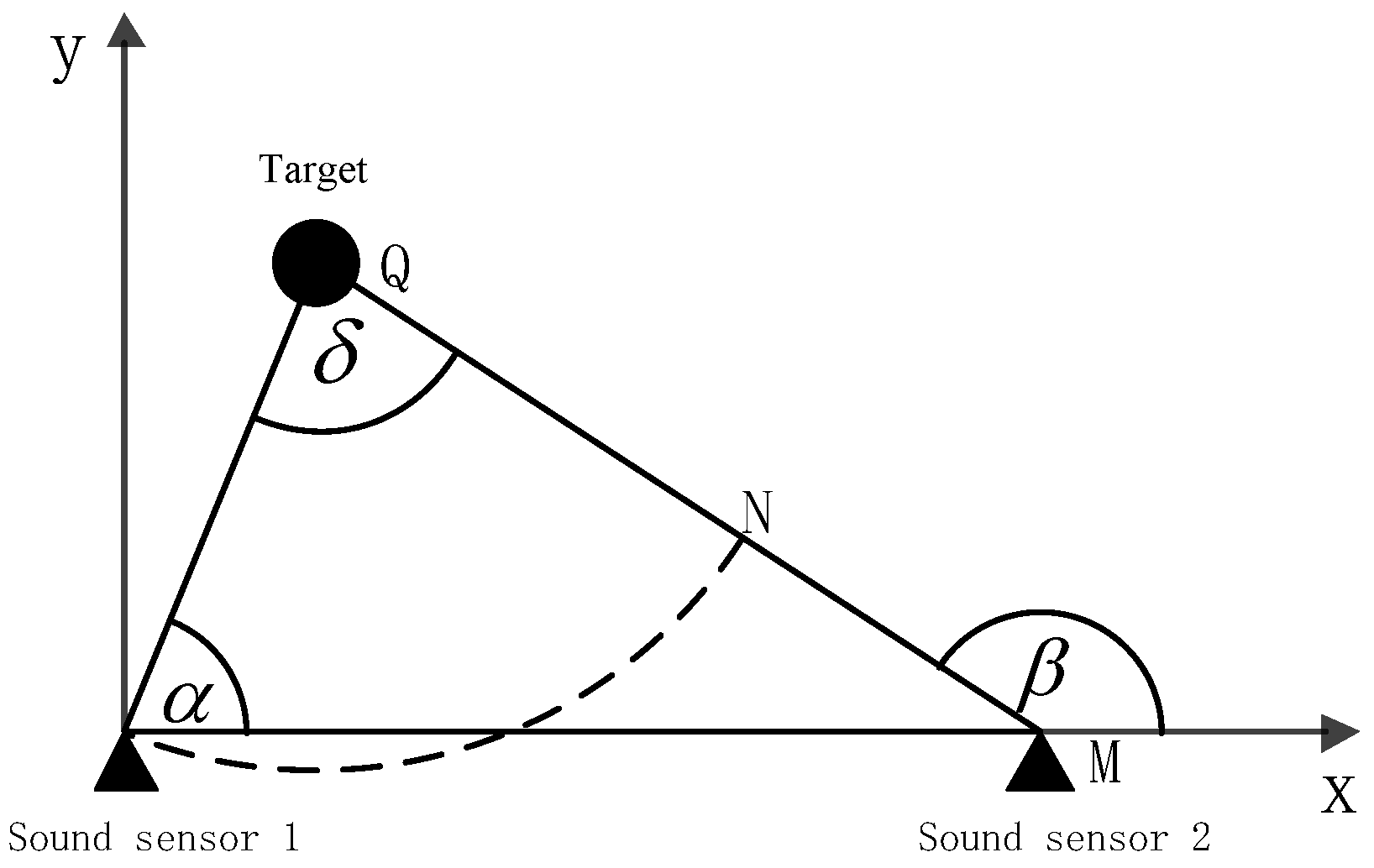
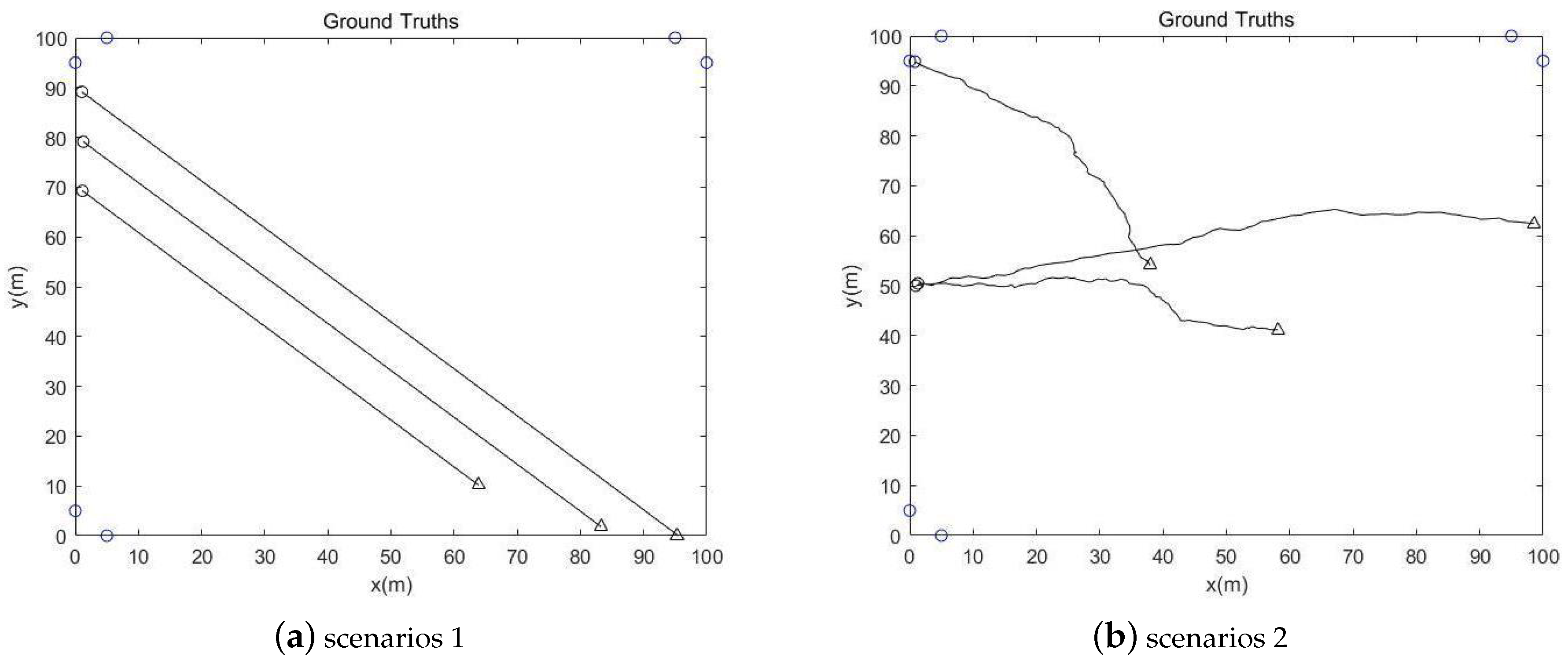
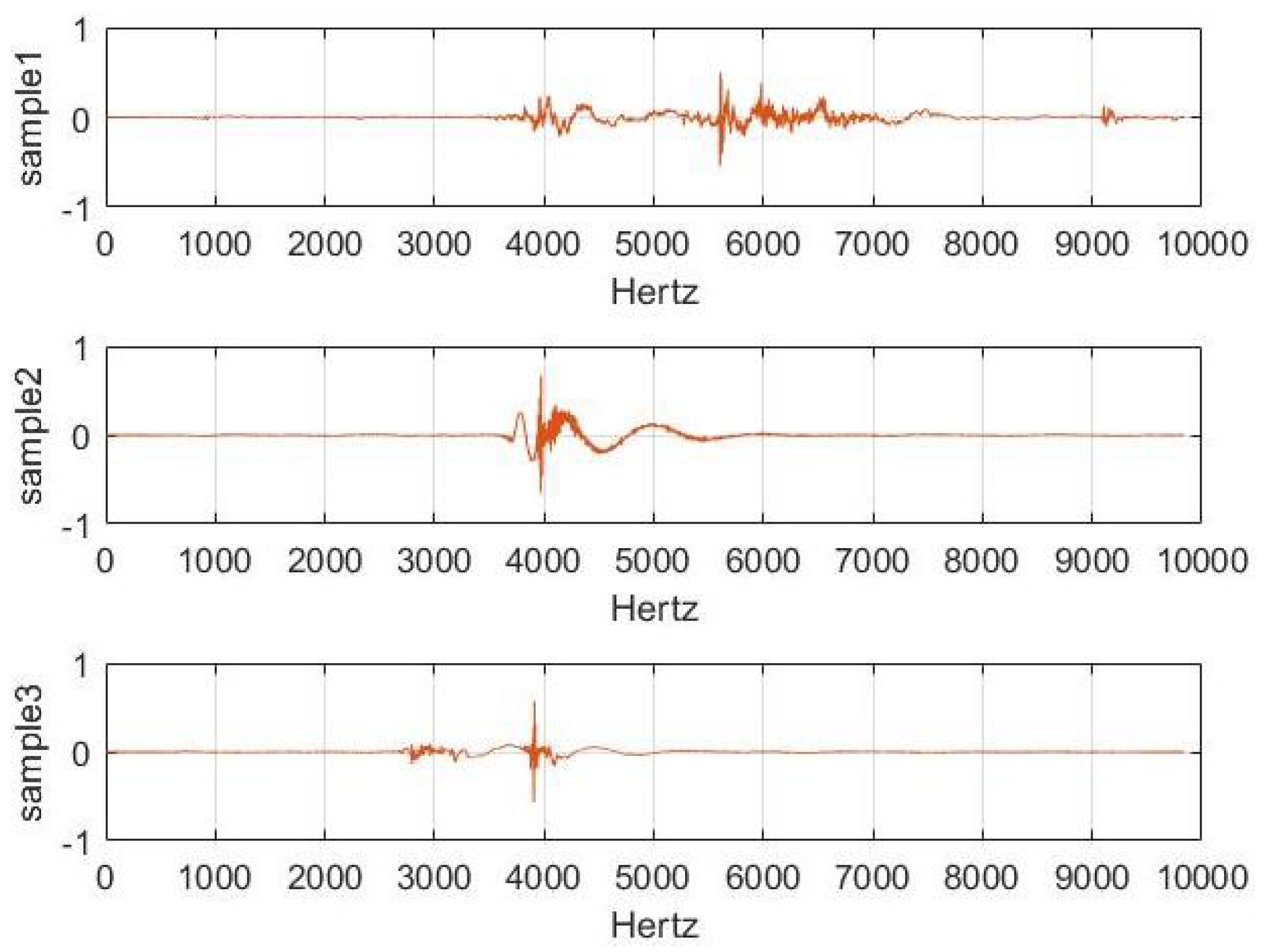
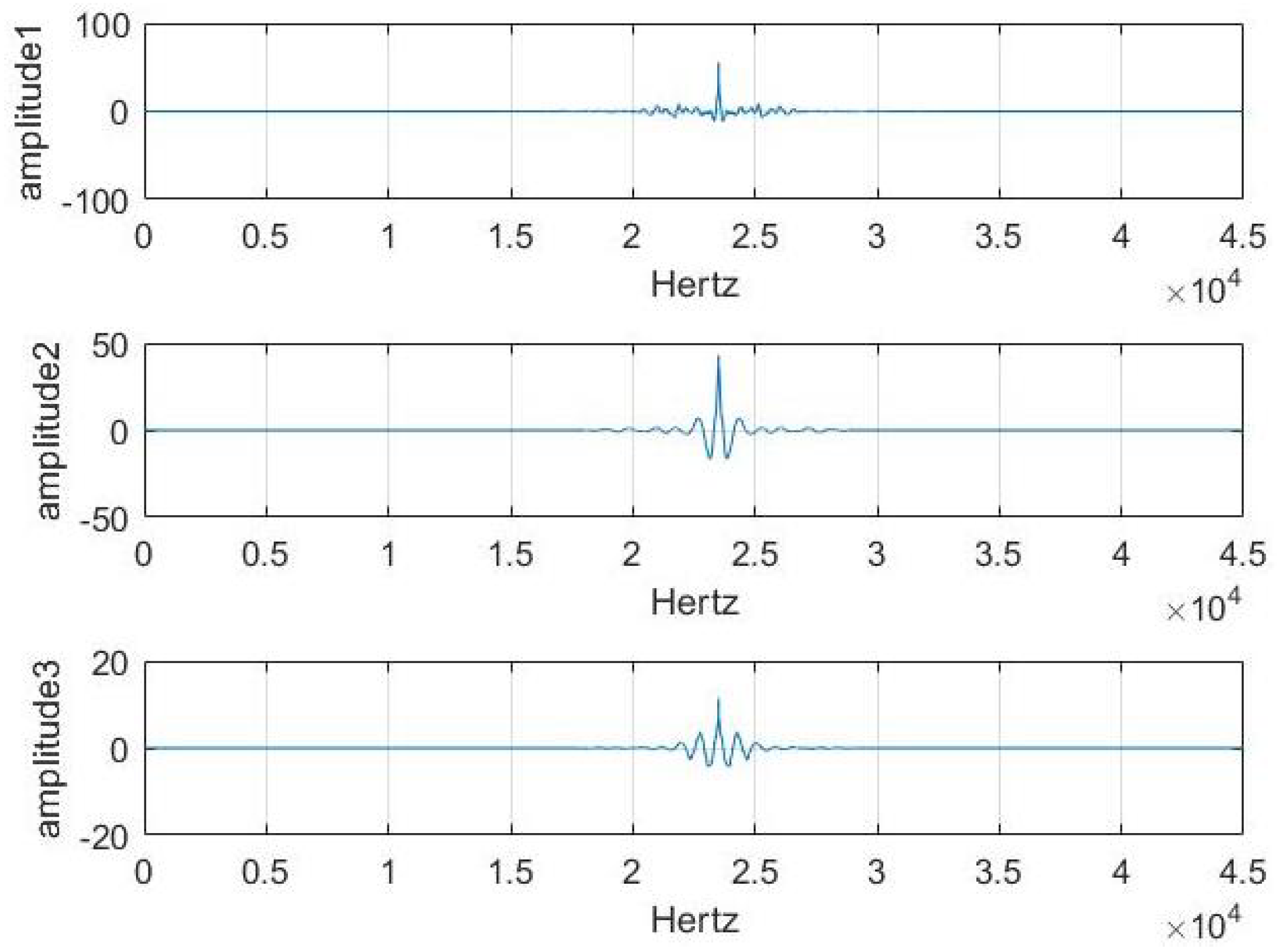
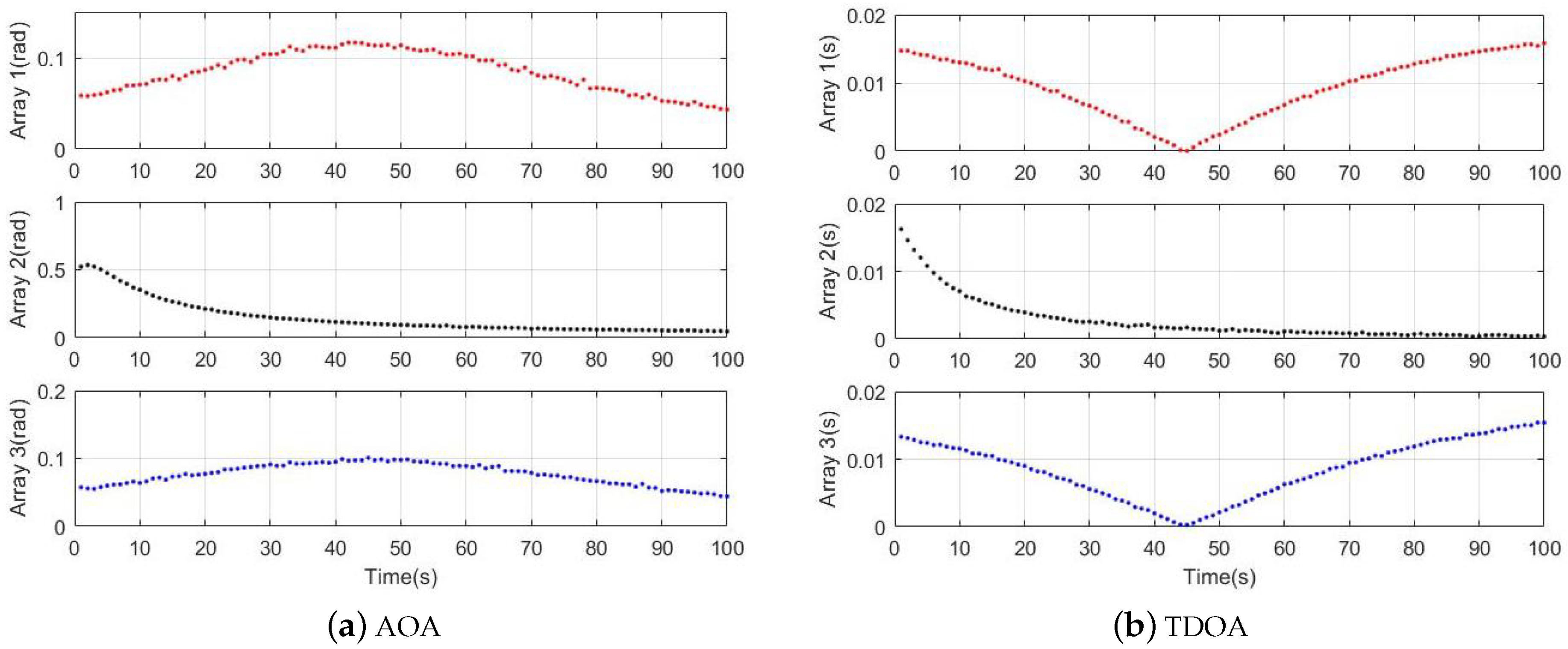
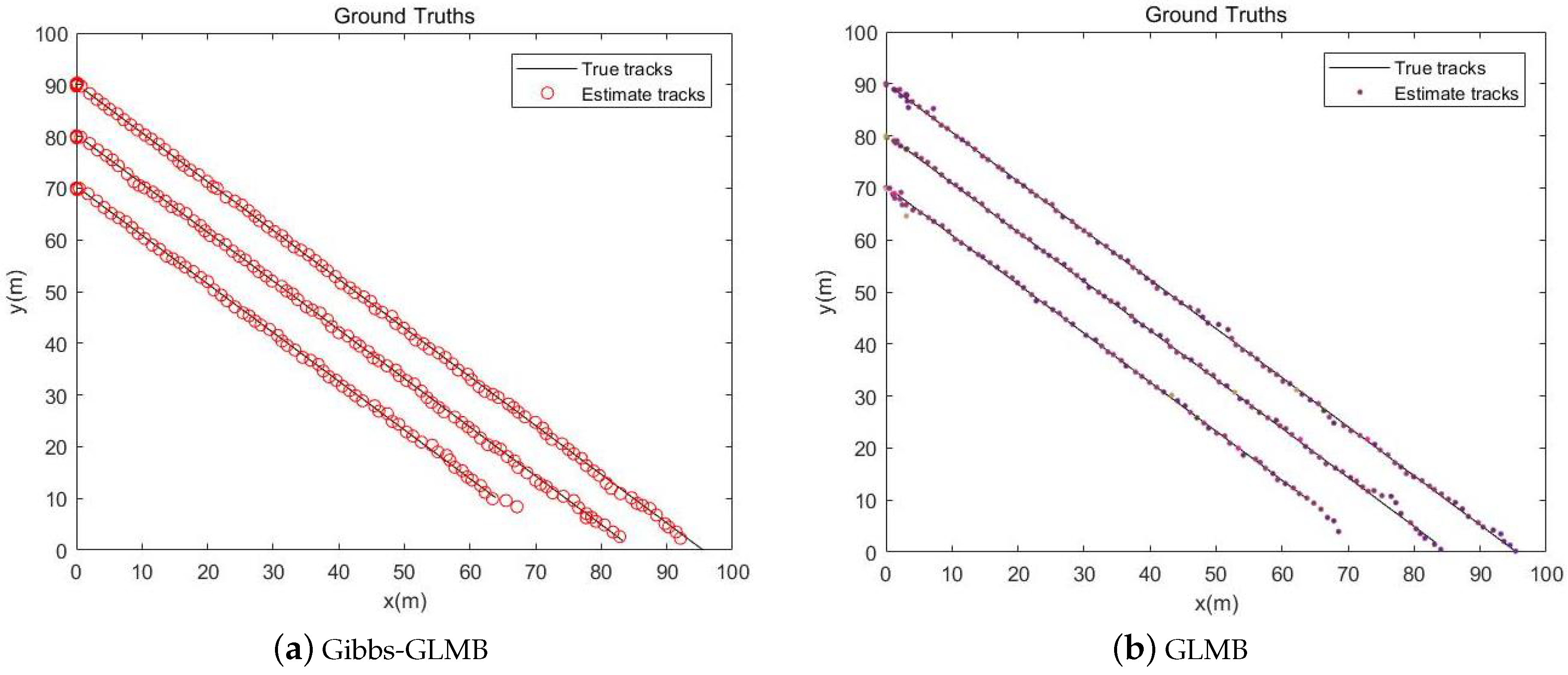
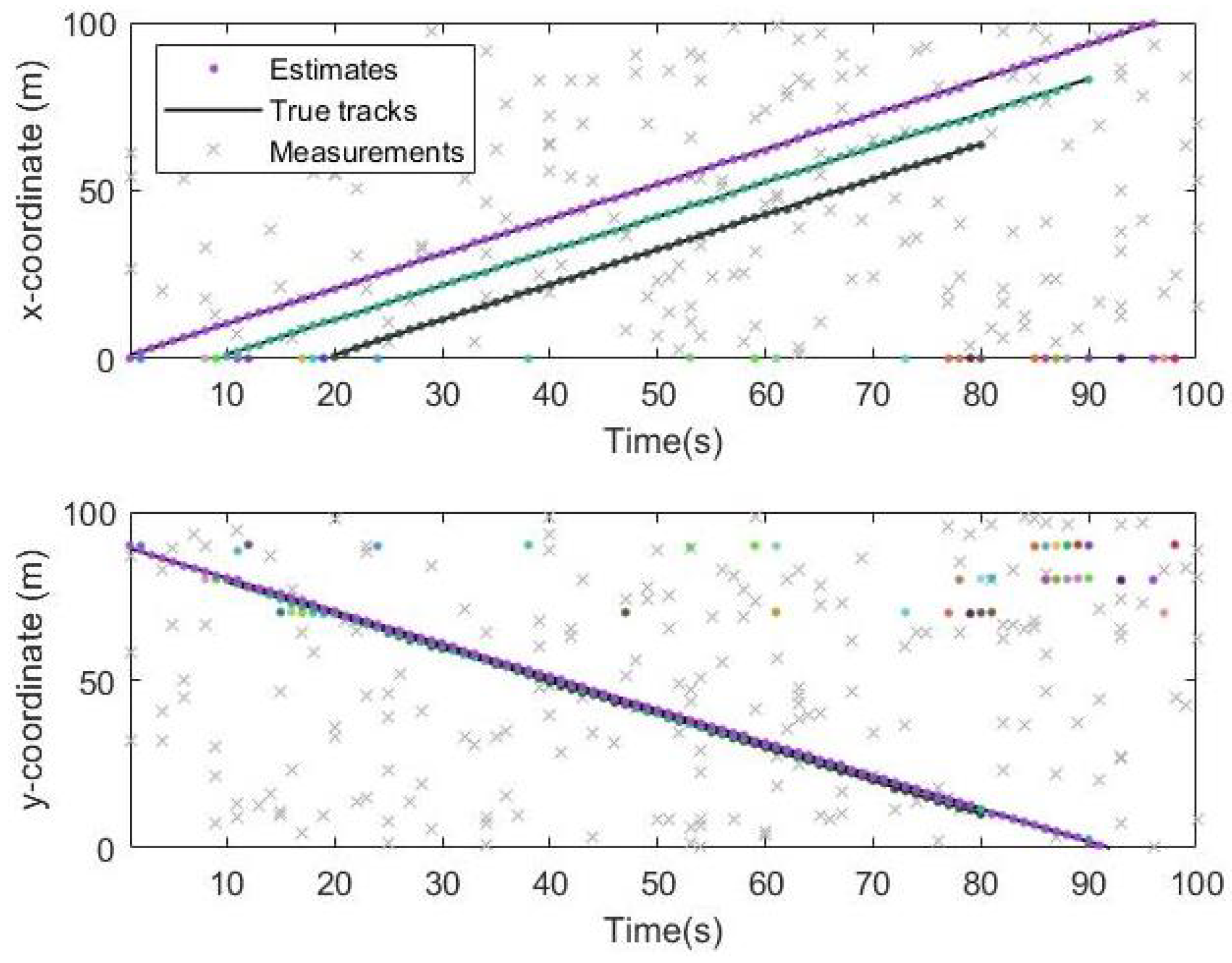
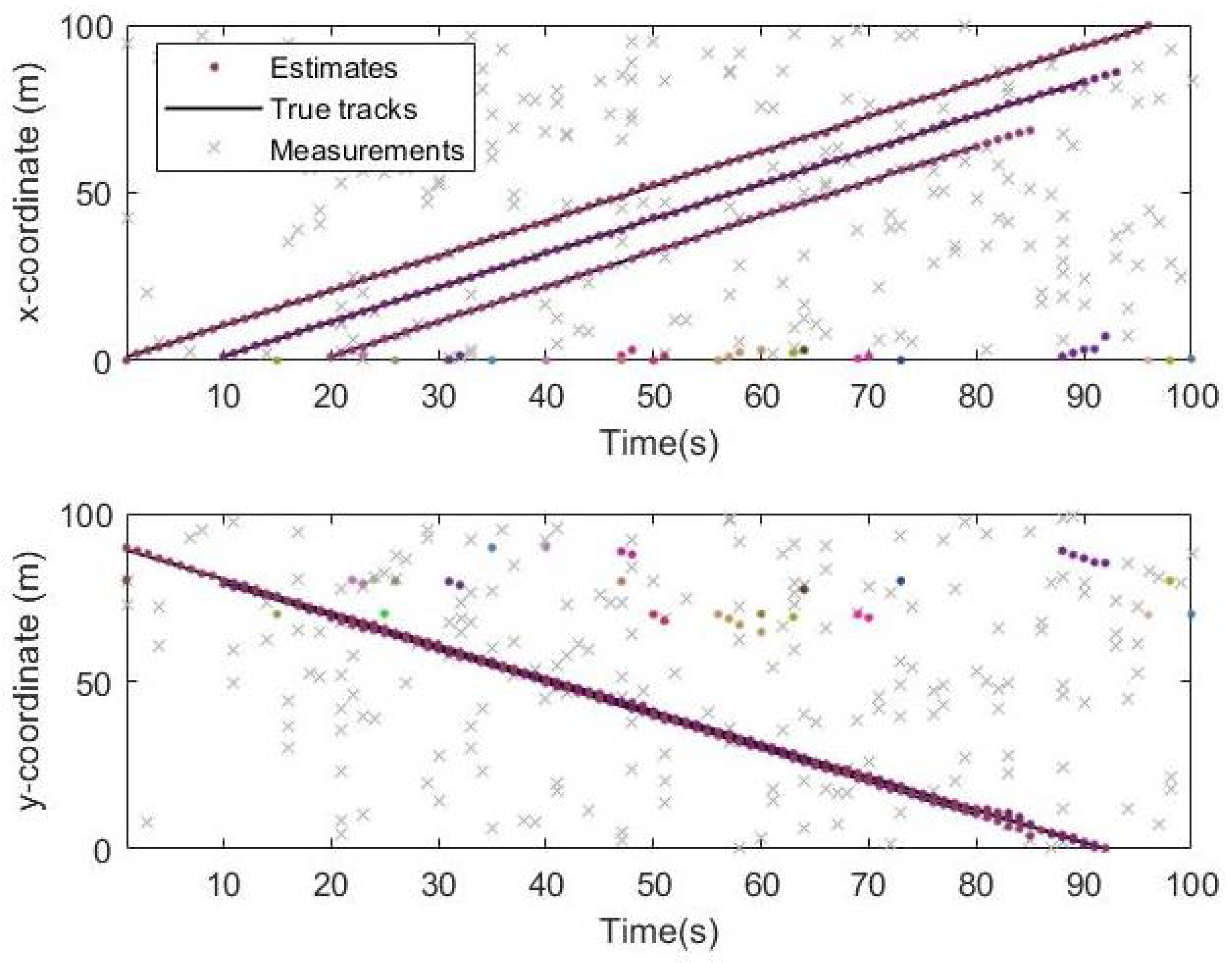
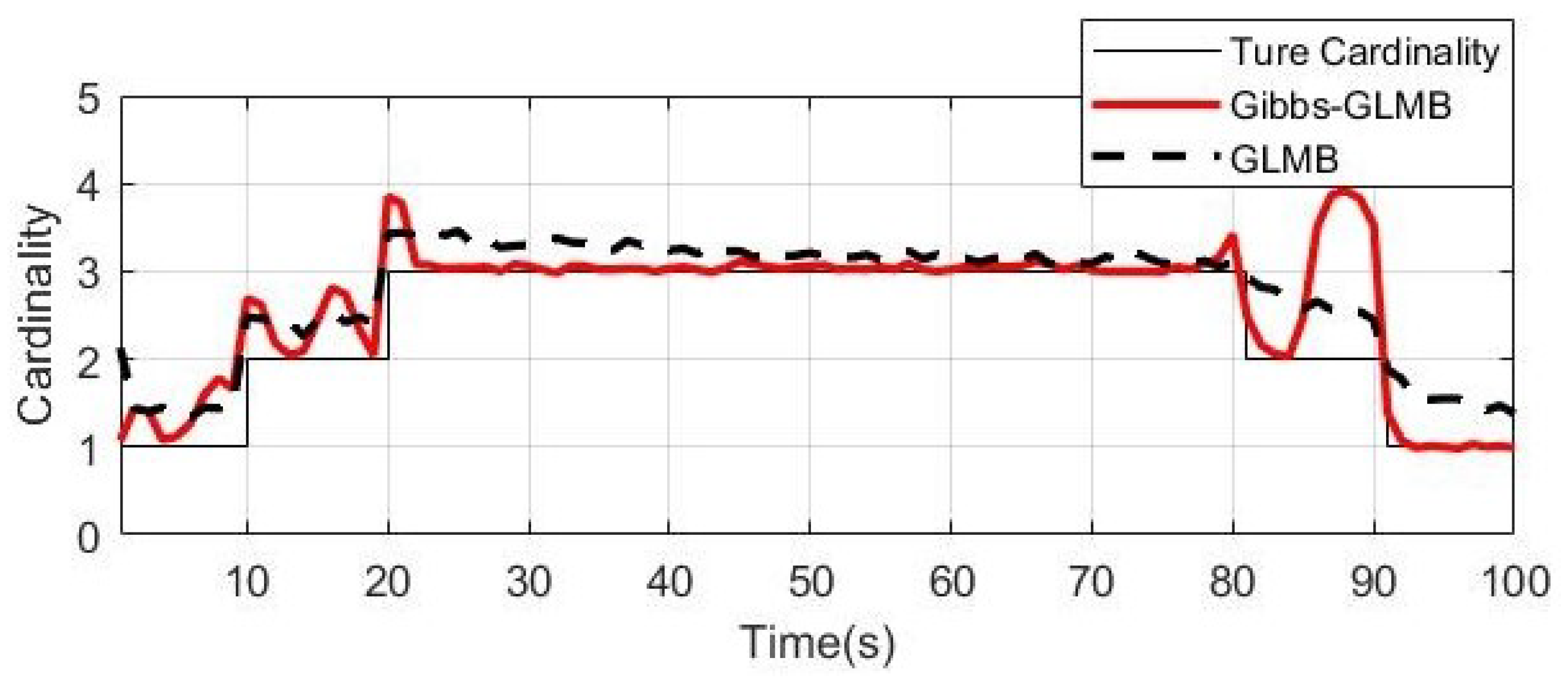
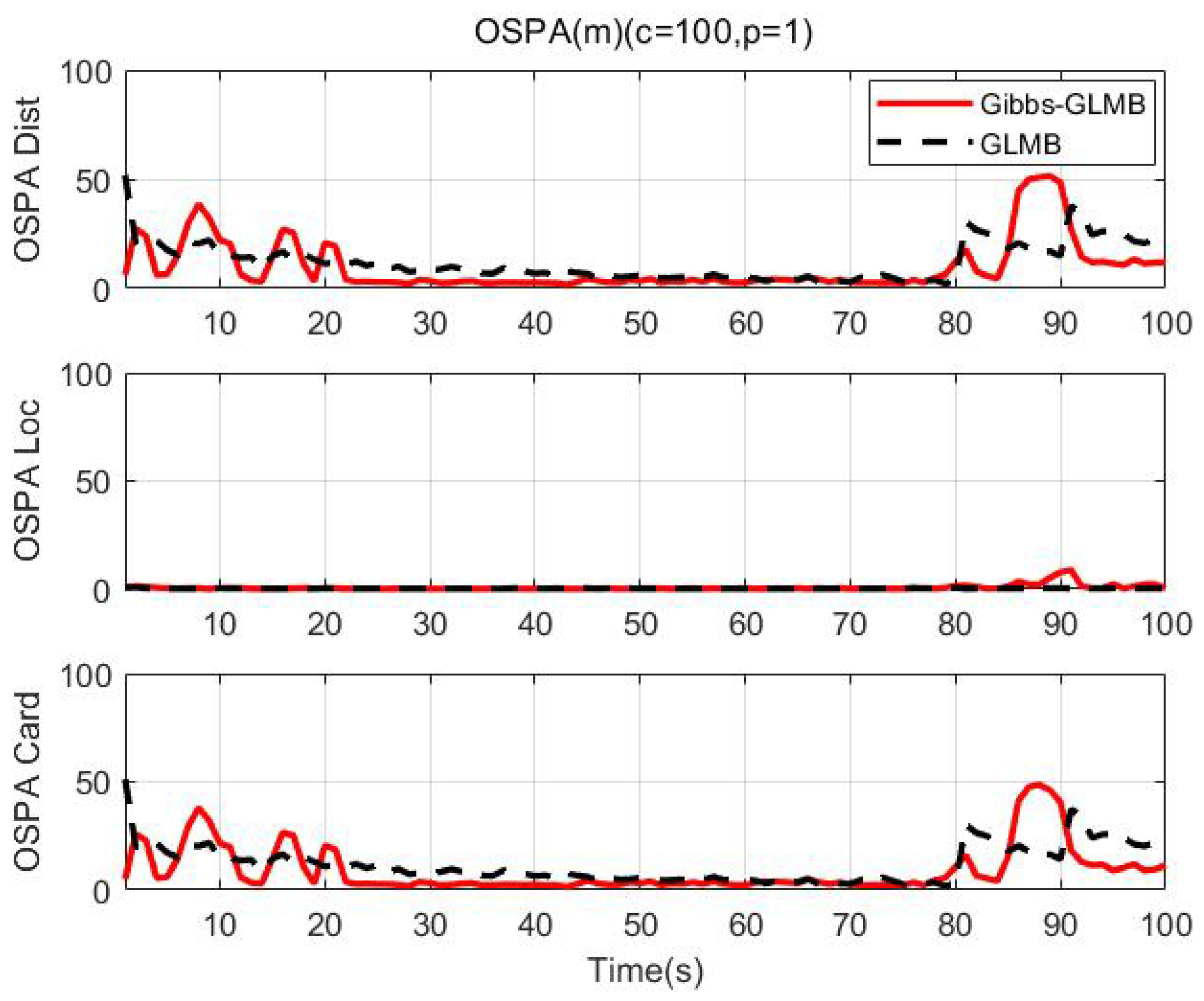
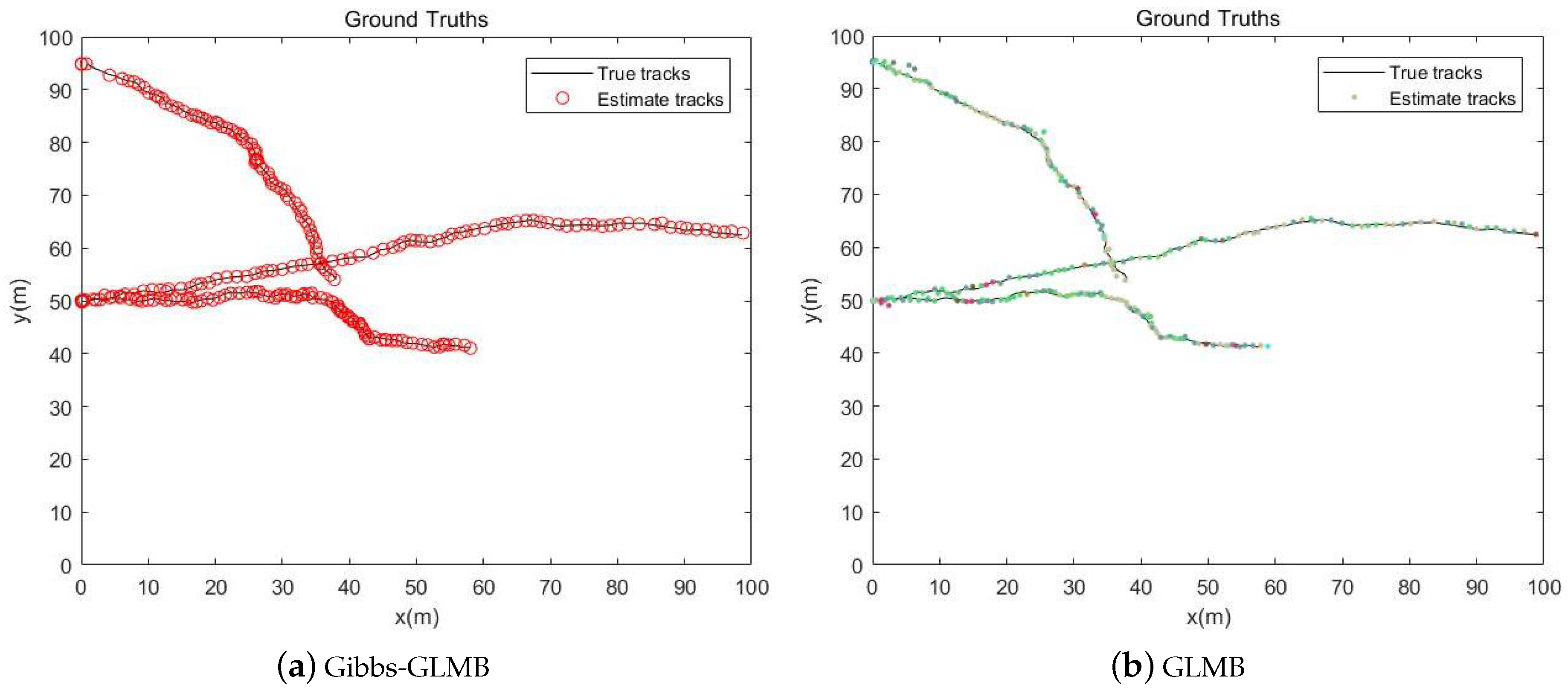
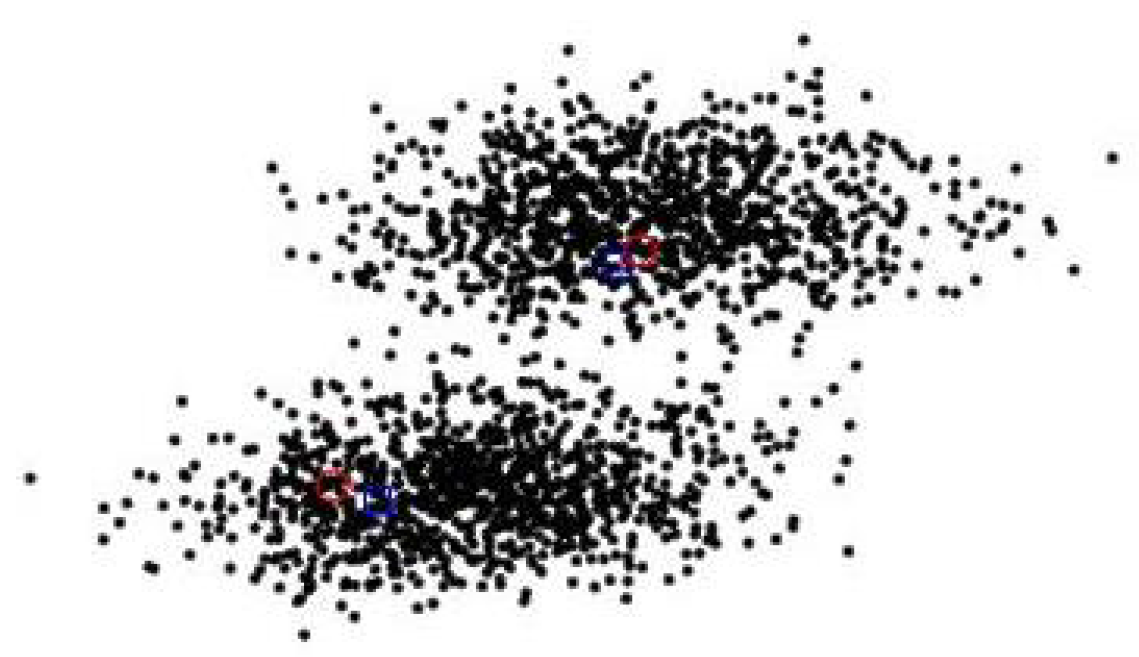
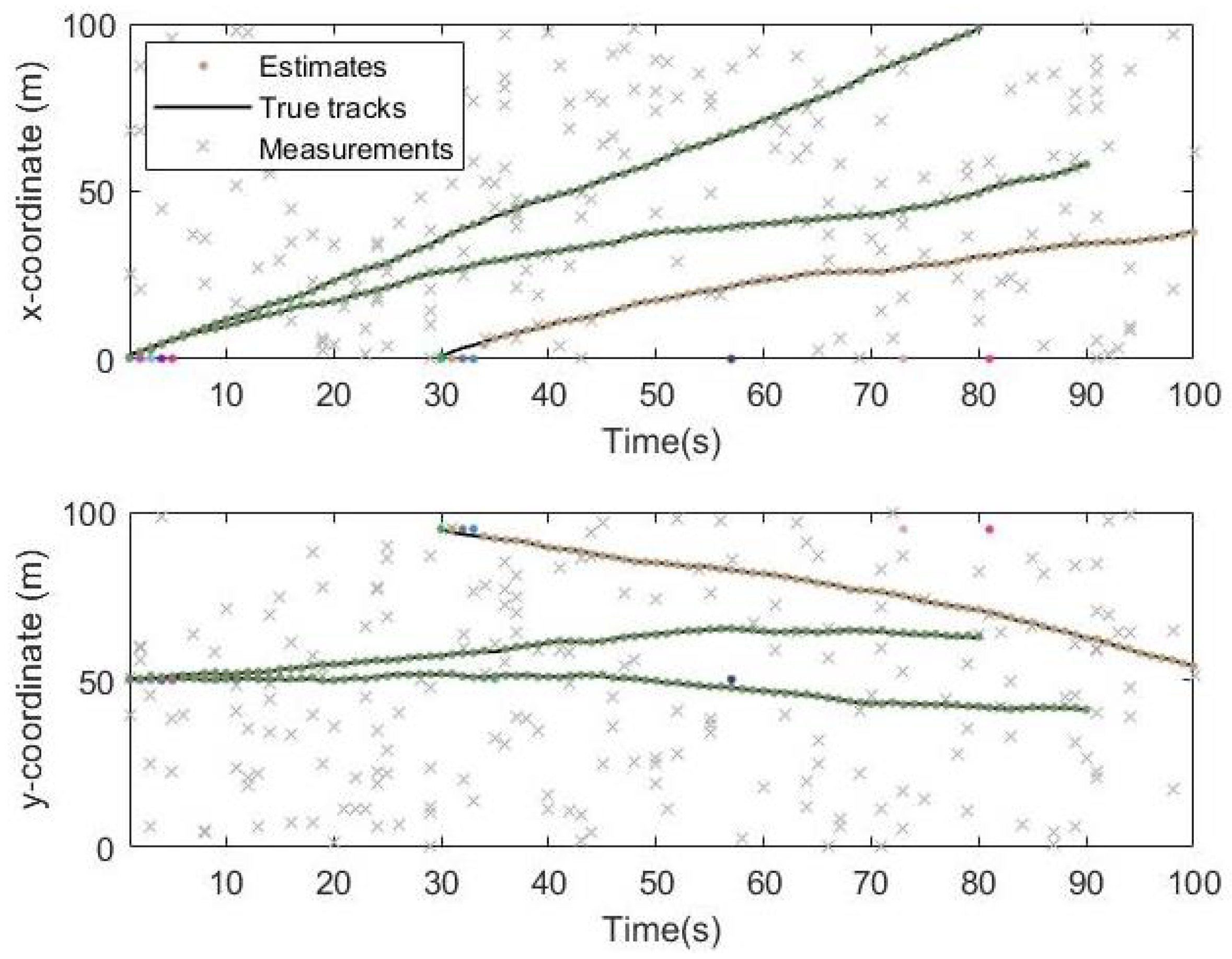
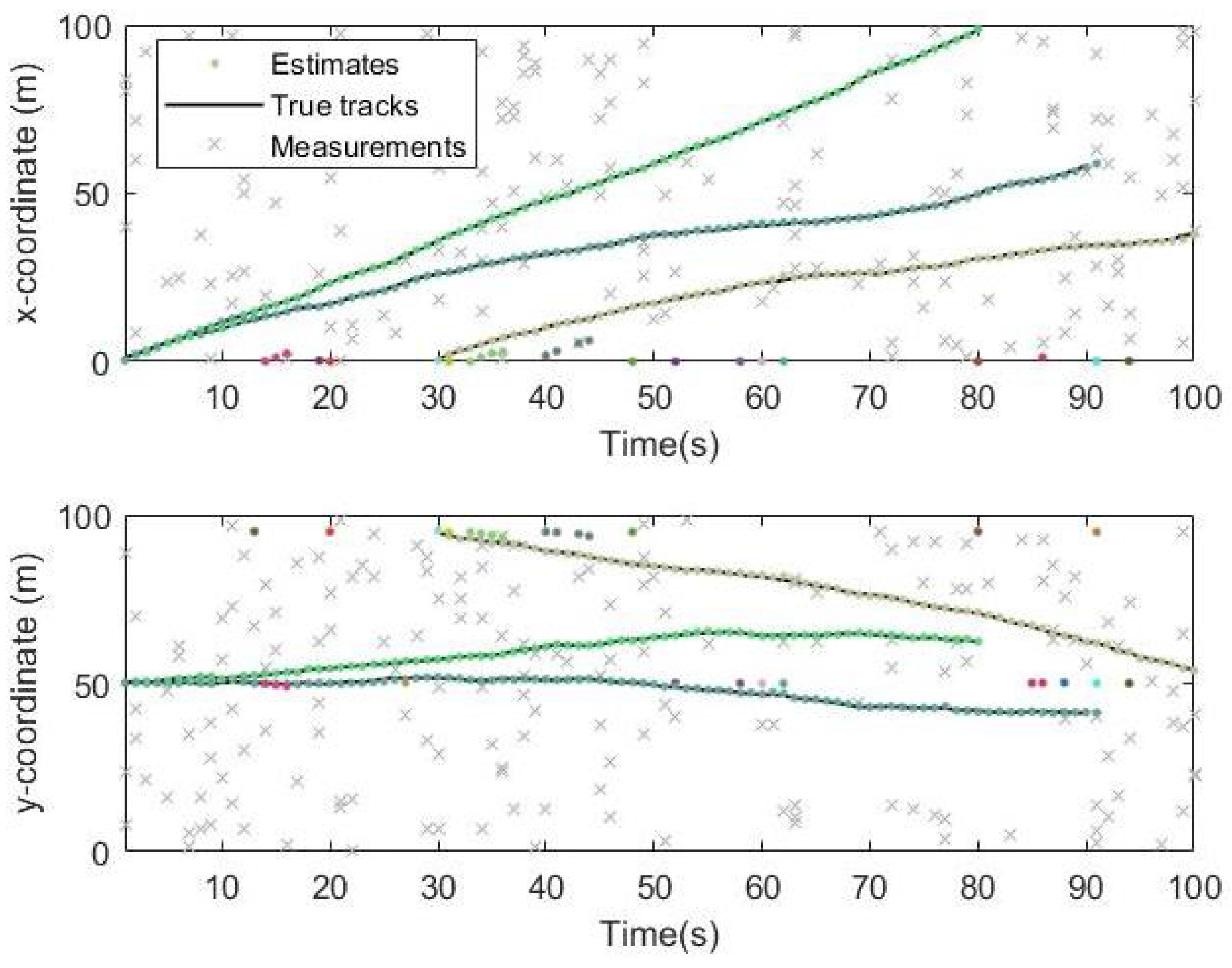
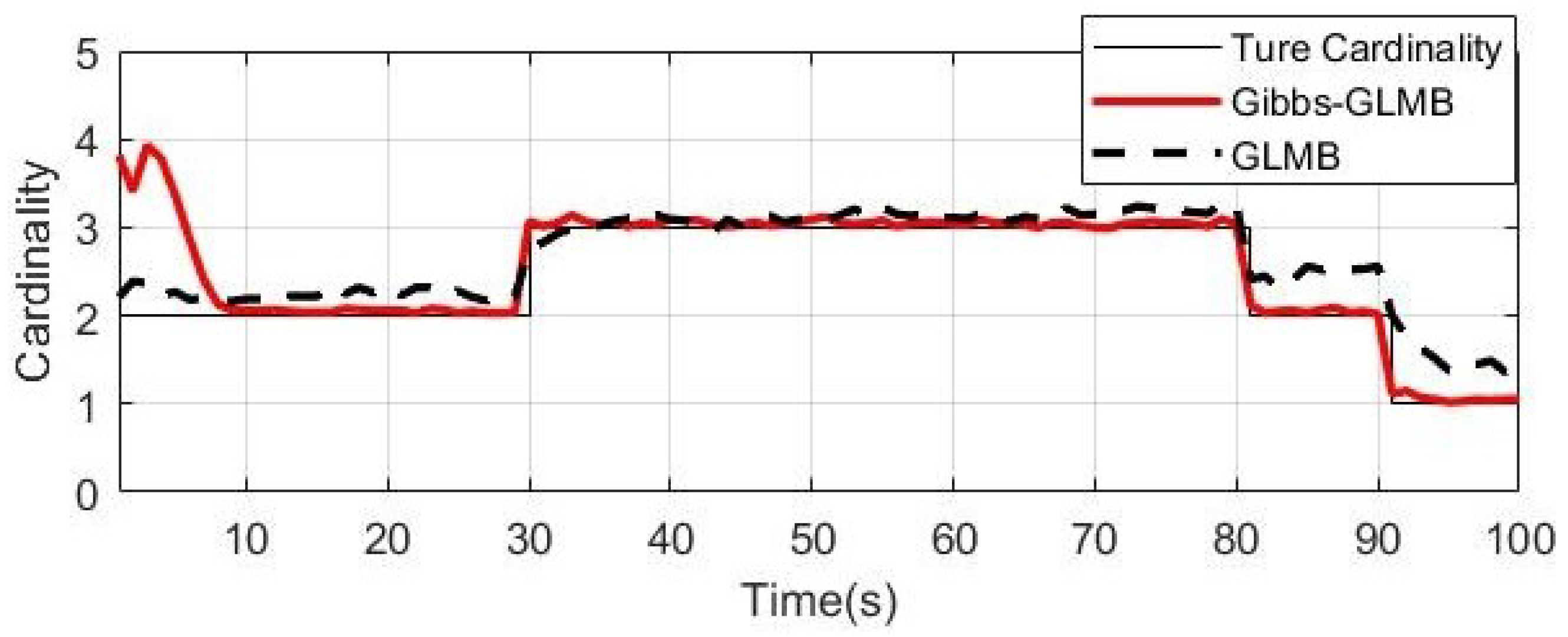
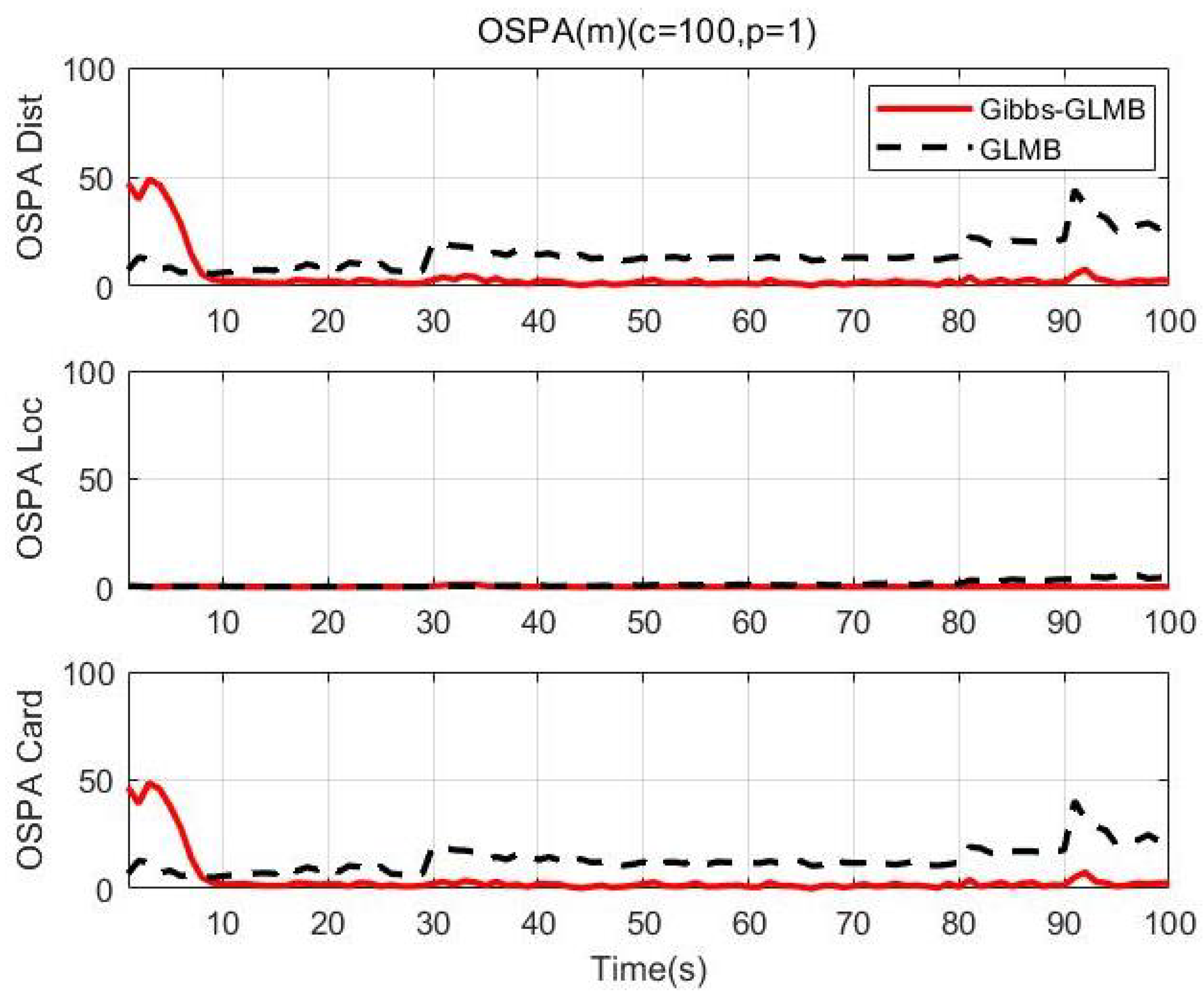
| Method | Scenario 1 | Scenario 2 | ||
|---|---|---|---|---|
| Running Time (s/step) | The Cardinality Accuracy | Running Time (s/step) | The Cardinality Accuracy | |
| Gibbs-GLMB | 0.5790 | 76.86% | 0.5950 | 88.61% |
| GLMB | 1.4188 | 67.64% | 2.1950 | 61.60% |
© 2019 by the authors. Licensee MDPI, Basel, Switzerland. This article is an open access article distributed under the terms and conditions of the Creative Commons Attribution (CC BY) license (http://creativecommons.org/licenses/by/4.0/).
Share and Cite
Tian, Z.; Liu, W.; Ru, X. Multi-Target Localization and Tracking Using TDOA and AOA Measurements Based on Gibbs-GLMB Filtering. Sensors 2019, 19, 5437. https://doi.org/10.3390/s19245437
Tian Z, Liu W, Ru X. Multi-Target Localization and Tracking Using TDOA and AOA Measurements Based on Gibbs-GLMB Filtering. Sensors. 2019; 19(24):5437. https://doi.org/10.3390/s19245437
Chicago/Turabian StyleTian, Zhengwang, Weifeng Liu, and Xinfeng Ru. 2019. "Multi-Target Localization and Tracking Using TDOA and AOA Measurements Based on Gibbs-GLMB Filtering" Sensors 19, no. 24: 5437. https://doi.org/10.3390/s19245437
APA StyleTian, Z., Liu, W., & Ru, X. (2019). Multi-Target Localization and Tracking Using TDOA and AOA Measurements Based on Gibbs-GLMB Filtering. Sensors, 19(24), 5437. https://doi.org/10.3390/s19245437




